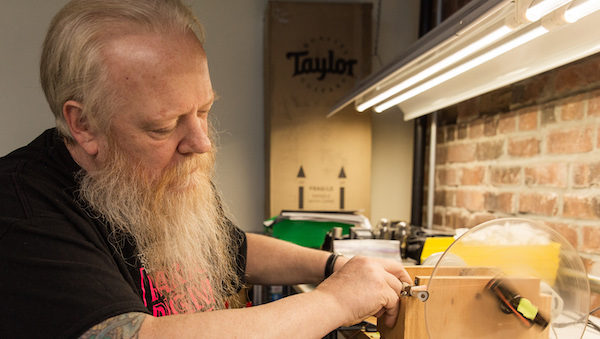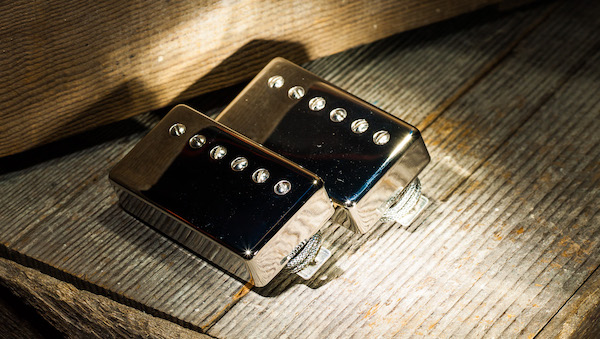What makes a good pickup?
Revered boutique pickup maker Jason Lollar on what to look for when you are upgrading pickups – and what 'low-wind' humbuckers actually do for your tone

Jason Lollar is so often named in discussions of great electric guitar pickups that he’s almost a kind of Old Master of the craft. His Imperial humbuckers have become a benchmark for how a modern recreation of a PAF should be so, with many guitarists upgrading pickups themselves, we asked him what the ingredients of a great pickup are?
“I like the pickup to be able to follow any kind of input that the player puts on the string, rather than the pickup itself dominating the sound,” Jason explains, speaking from his Tacoma manufacturing headquarters. “That takes a certain amount of attack and clarity,” he adds, “especially when you’re playing real close intervals. You also want a real open, even high-end and midrange.”
Lollar comes from a lutherie background so his viewpoint tends to take in the whole guitar when he talks about making good pickups. Since the early years of aftermarket pickups, when makers such as DiMarzio and Seymour Duncan appeared on the scene in the 1970s, guitar players have become steadily more aware of the influence of magnets, wire gauge and winding patterns on the performance of pickups.
Jason Lollar says a savvy maker needs to consider all the variables that can contribute to the perfect voicing for a pickup – and then carefully orchestrate them for the right result.
One thing a low-wind pickup does is tighten up that bottom-end, so you can goose your amp a little bit more
Jason Lollar
“We use a lot of different things,” he explains. “A tighter wind will give you more inductance and more output,” for example.
“With a looser wind you’ll get more of a brilliant sound with less drive. So it’s the way the pickup is wound but also the gauge of wire – smaller gauge wires can dampen some of the high-end. Then there’s the type of magnet and how much it’s charged or degaussed, which makes a big difference. Even the pickup cover material makes a difference. So there’s a lot to pay attention to,” he reflects.
Jason adds that when it comes to understanding how a pickup will perform, some commonly used rules of thumb can be more misleading than helpful. For example, DC resistance is often used as a measure of how hot a pickup is. Trouble is, says Jason, a pickup’s DC resistance reading isn’t fixed – and can literally change with the weather.
Get The Pick Newsletter
All the latest guitar news, interviews, lessons, reviews, deals and more, direct to your inbox!
“Most guitarists [judge a pickup by] the resistance, which is really kind of a poor way to judge what a pickup’s doing because resistance can vary even with air temperature,” he explains. “If the air temperature is 90 degrees [Fahrenheit], the pickup resistance is gonna read higher. If it’s 50 degrees, it’s going to read way lower.”
While Jason Lollar’s pickups are fitted as standard on many boutique and premium guitars, notably Eastman, some of his designs have acquired a kind of cult following in their own right, especially the Imperial humbucker. What was his train of thought when he was designing this well-known set?
“Well, I wanted it to be a kind of standard PAF output range and the Imperials are also designed to have a cover on because the pickup cover makes a difference in the sound,” he explains. “It evens out the high-end and it also gives the overall sound a little bit of a snarl. If you take that pickup cover off you don’t get that any more – it distorts the magnetic field a little bit.
- The best electric guitar pickups 2020: top single coils, humbuckers and P-90s to upgrade your tone

“Another thing we did on the Imperials was boost the output on the bridge pickup a little bit, so it balances better. I’ve got a ’63 ES-355 and a ’71 Les Paul Custom and, on both of those, you gotta roll the neck pickup volume down a little to get an even volume response from both pickups. I was aware of that happening with old Gibsons, so I designed our set so it wouldn’t sound wimpy when you went from the neck to the bridge.”
Like many premium PAF-style pickups, Lollar’s Imperials are offered in high-wind, standard and ‘low- wind’ variants. The latter term has become a bit of a buzzword among tone-hounds, especially in relation to vintage humbuckers. But what does it really mean in terms of practical pickup performance?
“Okay, if you’re playing on a Fender amp, for instance... those amps tend to ‘blat’ out on the low-end really quick. So you gotta roll off a lot of bottom-end from the amp if you’re playing loud with a fairly hot pickup. One thing that a low-wind pickup does is tighten up that bottom-end, so that you can goose your amp a little bit more without blatting out the bass.
“A low-wind also gives you just a little bit more sparkle on the top-end,” he continues. “So you can get a little bit more clarity out of a semi-hollow guitar. Finally, if you’re a player who uses chord inversions that feature really close intervals... the low-winds really accentuate that. You can really get much more clarity out of the bass. So that’s really what that’s about,” Lollar concludes.
Jamie Dickson is Editor-in-Chief of Guitarist magazine, Britain's best-selling and longest-running monthly for guitar players. He started his career at the Daily Telegraph in London, where his first assignment was interviewing blue-eyed soul legend Robert Palmer, going on to become a full-time author on music, writing for benchmark references such as 1001 Albums You Must Hear Before You Die and Dorling Kindersley's How To Play Guitar Step By Step. He joined Guitarist in 2011 and since then it has been his privilege to interview everyone from B.B. King to St. Vincent for Guitarist's readers, while sharing insights into scores of historic guitars, from Rory Gallagher's '61 Strat to the first Martin D-28 ever made.





![[from left] George Harrison with his Gretsch Country Gentleman, Norman Harris of Norman's Rare Guitars holds a gold-top Les Paul, John Fogerty with his legendary 1969 Rickenbacker](https://cdn.mos.cms.futurecdn.net/TuH3nuhn9etqjdn5sy4ntW.jpg)





